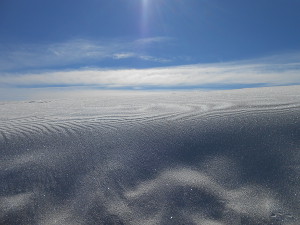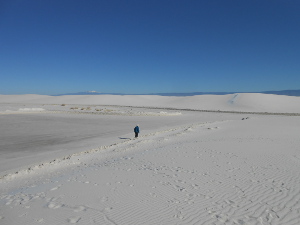 Dunes fade into clouds
Dunes fade into clouds
 Dunes fade into clouds
Dunes fade into clouds
It is very easy to bypass White Sands National Monument, partly because the distances in the West seem so vast that the traveller feels compelled to press on, partly because there is real uncertainty about where to find the next place to spend a night.
But on this trip we managed to plan our arrival at the Monument's entrance just before mid-morning, which gave us time to drive the short road into the main visitor locations, explore the Visitor Center and its excellent video, and finish by clambering around on one of the dunes, before continuing on East.
The loop road through the Monument is listed as one of the country's most scenic  Bob examining the crystals
highways in the National Geographic book of scenic byways, and deservedly so. Starting out south of the dunes, the road skirts the growing lines of duneland and then plunges in to a landscape that grows whiter and whiter until it dazzles the eyes. The parking areas are big enough to hold hundreds of cars, but only a dozen or so were in the park this day. The gate guard told us it was a favorite attraction of college students on spring break, so much so that a sign is posted forbidding alcohol consumption, February through May.
Bob examining the crystals
highways in the National Geographic book of scenic byways, and deservedly so. Starting out south of the dunes, the road skirts the growing lines of duneland and then plunges in to a landscape that grows whiter and whiter until it dazzles the eyes. The parking areas are big enough to hold hundreds of cars, but only a dozen or so were in the park this day. The gate guard told us it was a favorite attraction of college students on spring break, so much so that a sign is posted forbidding alcohol consumption, February through May.
The sands are gypsum crystals formed by evaporation of the local lake beds and ground to powder by the unceasing desert winds. In contrast to the silica sands common on beaches  Elsa walking in a sea of white
and other dunes, the gypsum is sparkly and bright and makes wonderfully white hills. When the crystals catch the rays of the brilliant desert sun they act like prisms, refracting light in different colors twinkling all over the dunes.
Elsa walking in a sea of white
and other dunes, the gypsum is sparkly and bright and makes wonderfully white hills. When the crystals catch the rays of the brilliant desert sun they act like prisms, refracting light in different colors twinkling all over the dunes.
They are also firm hills, even though the dunes themselves move several feet each year. They move when the winds blow up to 15 to 20 miles per hour. Some yuccas have managed to grow above the sandy surface; their roots may extend twenty feet down to preserve the connection to life-giving water. When the dune moves totally past the yucca collapses, its long "trunk" coiled on the ground like a serpent. Other desert shrubs looked like they were growing in pots, as the sand piled itself about the
 Our shadows
base which extended several feet above the ground. The video we watched told us that the insects and reptiles native to White Sands have adapted by becoming pale-to-white. Today we saw no wildlife.
Our shadows
base which extended several feet above the ground. The video we watched told us that the insects and reptiles native to White Sands have adapted by becoming pale-to-white. Today we saw no wildlife.
When we walked, we left light, delicate footprints where other animals and birds had walked, but the ripples and the footprints and the marks of the occasional pebble or branch looked as though they would last a long time - until the next big wind. The incline was gentle as we slowly ascended the done until we were fifteen or twenty feet above the truck and could look out over a sea of sinuously curving shining white dunes. This is the only gypsum sand dune site in the world, and it is truly wonderful!
It was quiet and calm among the dunes. The few visitors had enough room to spread out among the parking spaces which have been created, so we felt we had the place all to ourselves.